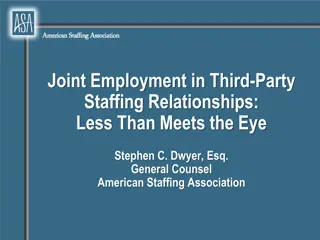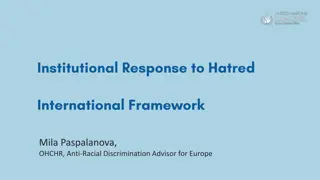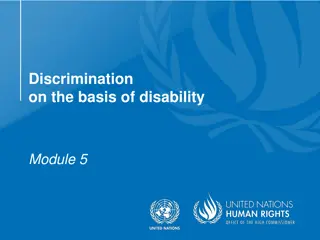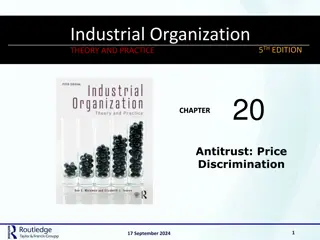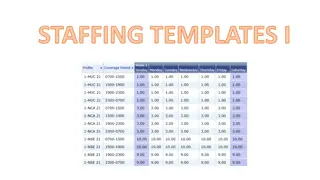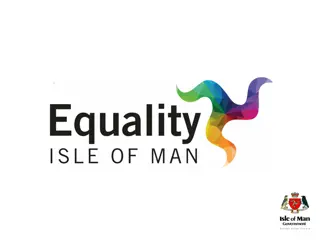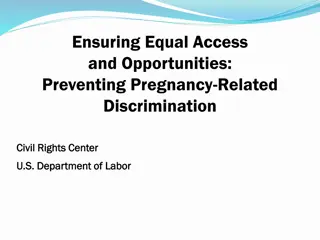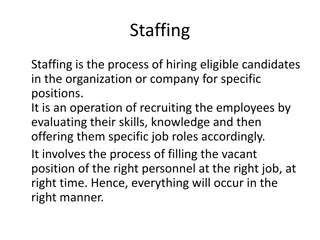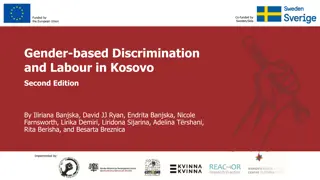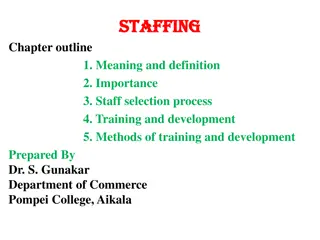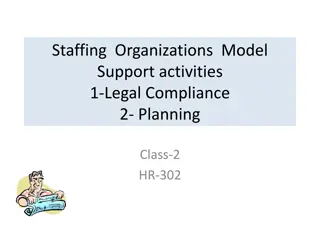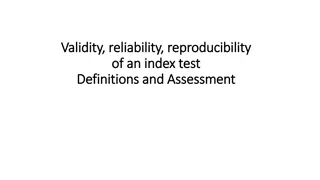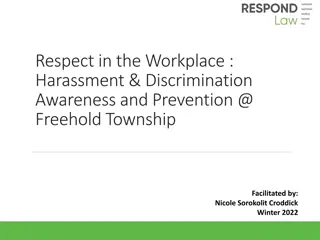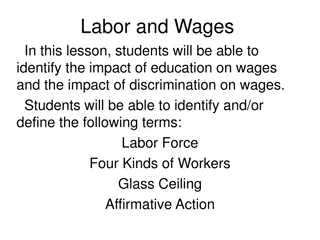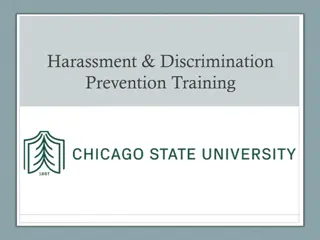Insights on Staffing and Selection Methods: Validity and Discrimination
This research explores the validity and utility of staffing and selection methods, focusing on discrimination in resume screening, impression management in interviews, HRM effective practices, and networking on voluntary turnover. The study highlights the impact of multiple social categories, implicit biases, and recruiter attitudes on job suitability ratings for Arab male/female applicants in low-demand jobs.
Uploaded on Sep 28, 2024 | 0 Views
Download Presentation

Please find below an Image/Link to download the presentation.
The content on the website is provided AS IS for your information and personal use only. It may not be sold, licensed, or shared on other websites without obtaining consent from the author. Download presentation by click this link. If you encounter any issues during the download, it is possible that the publisher has removed the file from their server.
E N D
Presentation Transcript
Staffing and Selection Methods and their Validity/Utility By Rupa Padhy, Jose Vasquez, Priyanka Neelakrishnan, Arvin Emadi
Agenda Discrimination in Resume Screening -Rupa Padhy Impression Management in Interviews -Jose Vasque HRM effective practices -Priyanka Neelakrishnan Networking on Voluntary Turnover -Arvin Emadi
Discrimination in Resume Screening RUPA PADHY Based on the article Double Jeopardy Upon Resume Screening: When Achmed is Less Employed than Aisha Personnel Psychology (2015) 68: 659-696
Overview of the Research Arabs in Netherlands: largest ethnic minority group with 2x unemployment rate compared to host ethnicity Previous Studies Single Social category Students Less reliable Present Study Multiple Social category (ethnicity and gender) Actual recruiters Higher Validity and Reliability
MEANING KEY TERMs Multiple Categorization Individuals belong to multiple social groups (e.g., ethnic, sex, religion, age ) Eg: employment discrimination minority men (29.5%) vs minority women (22.5%) for Arabs Job Contingencies The nature of the job might affect views of multiple category (sex and ethnicity) Eg: Arab women are viewed better match for high client contact jobs the amount of external client interaction Recruiters Prejudice Recruiter s attitudes toward members of groups (i.e. prejudice) Eg: high ethnic prejudice will pay more attention to ethnicity Implicit Association Test -Implicit ways of measuring prejudiced attitudes -Measures different psychological domains, such as ethnic discrimination
Research Method-Study 1 Participants: 60 non-Arab/Dutch recruiters 41.5% male 3 to 10 years of recruiting experience Method: 1. Recruiters were randomly assigned to evaluate four resume s by rating applicants job suitability. a. 2 (Ethnicity) 2 (Sex) 2 (Client contact) design for Clerical (low demand) jobs 2. Recruiter took two IAT test-ethnic and gender role (E-prime v2.0.) Arab-IAT for ethnic prejudice -paired Arab/Dutch names with pleasant/unpleasant words Gender-roles IAT for sexism -paired female/male words with career/domestic-related words 1. Lastly, Recruiters took an online Survey
Moderating Effects of Recruiters Implicit Sexism on Job Suitability Ratings of Arab Male/Female Applicants Applying for Low-Demand Jobs With Low/High Client Contact Inference: Hiring discrimination was found against Arab Men (minority) in low-demand jobs
Research Method-Study 2 Participants: 124 Non-Arab / Dutch recruiters 57.8% male 3 to 10 years of recruiting experience Method: Consultancy job High Demand jobs Multiple category: [3 (Ethnicity) x 2 (Sex) x 3 (Client Contact)]
Interaction of Ethnicity and Sex by Client Contact Client Contact -Low Client Contact -Moderate Client Contact -High
Suitability Ratings of Dutch, Mixed, & Arab with Low/Medium/High Client Contact Ethnic Prejudice: Low Ethnic Prejudice: High Inference: Arab men faced hiring discrimination even for high demanding jobs
Practical Implications For Recruiters : Educate regarding structured screening procedure Create awareness with a training program on job stereotypes , their biases, broader diversity Use competency-based resume screening For Organizations : Make recruiters more accountable for resume screening Use of technology like Application Tracking System can reduce recruiter's attention to biases Use of Panel Screening-multiple recruiters screening piles of resume
Can Honest and Deceptive Impression Management Be Detected? Jose Vasquez Based on the article Honest and Deceptive Impression Management In the Employment Interview: Can It Be Detected and How Does It Impact Evaluations Personnel Psychology (2015) 68: 395-444
What is Impression Management? Impression Management Honest Self-promotion Deceptive Lying, image creation A company hiring half of applicants could hire up to 31% of people who falsified responses during the selection process. (Griffith, Chmielowski, and Yoshita (2007)
Study Overview 5 studies Sample Size 516 Interviewers 246 Professionals 270 Novice Goal Can Interviewers detect honest and deceptive IM Can they detect higher than chance level What questions make it easier to detect IM
Study 1 Participants Gender Education Interview Experience Mean: 9.6 years Position HR Assistant Method Interviewers asked standard interview questions Situation-task-action-results (STAR) 154 Professional Interviewers 48.7% Female 51.3% Male 61.7% had a university degree or equivalent
Study 2 Participants Gender Education Interview Experience Mean: 10.4 years Position Project Manager Method Past-behavior and situational questions If working on a team project that is due at the end of the day, how would you manage the team 92 Professional Interviewers 52.2% Female 47.8% Male 82.6 % had a university degree or equivalent
Study 3 Participants Gender Education Interview Experience Average of 3 interviews Method Past behavior or situational questions 136 Students 58.1% Female 41.9% Male 57% Business, 43% Law
Study 4 Participants Gender Education Interview Experience Average of 3.9 interviews Method 5-minute video, measured performance and then coded IM while rewatching 48 Students 42% Female 58% Male 27% Business/Econ, 49% Humanities, 19% Social Sciences, 14% Other
Study 5 Participants Gender Education Interview Experience Average of 3 interviews Method Watched 5 minute video, rated performance and IM perception Detections None of the IM tactics reached standard levels of significance 86 Students 51% Female 49% Male 35% Business/Econ, 34% Law, 19% Engineering, 13% Social Sciences,
Results Study 1 Study 2 Study 3 Study 4 Study 5 Above Chance Level 67% 60% 80% 54% N/A Below Chance Level 24% 37% 15% 42% N/A
Conclusion For Research: Larger sample sizes (Studies 4 and 5 were small) Gender can be a difference (Study 2) Age and interview experience did not have an effect For Recruiters : Detecting IM is difficult for Recruiters Ask behavioral, situational and more detailed questions Longer interviews
HRM and Organisational Effectiveness Priyanka Neelakrishnan
Effect of Internal and External Networking on Voluntary Turnover Arvin Emadi Based on INTERNAL AND EXTERNAL NETWORKING DIFFERENTIALLY PREDICT TURNOVER THROUGH JOB EMBEDDEDNESS AND JOB OFFERS Personnel Psychology (2016) 69, 635 672
TERMINOLOGY Voluntary Turnover: Employee(s) willingly choose to leave their position Internal Networking: Networking with coworkers within one s organization External Networking: Networking with colleagues across different organizations Job embeddedness: The extent to which people feel attached, regardless of why
VOLUNTARY TURNOVER CONSEQUENCE Loss of human capital Loss of knowledge Substantial potential costs 90% - 200% of leaver s annual salary Recruitment Selection Training Allen, Bryant, Vardaman 2010; Cascio 2006; Woo, Maertz 2012
DOES EMPLOYEES NETWORKING RELATE TO VOLUNTARY TURNOVER? WHEN? Internal Networking External Networking WHY? Desire to remain Job satisfaction Job embeddedness Perceived alternatives Opportunities to exit Job offers
WHAT ARE NETWORKING BEHAVIORS Definition: Building, Maintaining, and Using informal relationships in work-related activities by Granting access to resources Maximizing common advantages Behavior Example of Internal Building Internal Maintaining Internal Using External Building External Maintaining External Using Using company events to make contancts Catching up with people in other groups on what they do Receing confidential business advice from people on projects Developing informal contacts outside the company Keeping contacts with ex-colleagues Exchanging tips with people on other companies
INTERNAL NETWORKING OUTCOMES Increased perception of support Exchange of resources: Instrumental (how to handle a situation) Expressive (emotional support) Positive loop with job satisfaction Fostering job embeddedness: Links: Connections forces Fit: Comfort with the job and people Sacrifice: Psychological cost of leaving
EXTERNAL NETWORKING OUTCOMES Increased alternative employment opportunities Perception of one s abilities Attainment of job offers (referrals etc.)
THEORY AND HYPOTHESES Internal networking reduces the likelihood of turnover External networking increases the likelihood of turnover Job satisfaction mediates internal networking and turnover Job embeddedness mediates internal networking and turnover Perceived employment opportunity mediates external networking and turnover Job offers mediate external networking and turnover
METHODOLOGY 2 years later Phase 1 Phase 2 Contacted 2,936 professionals 540 responded (18.4%) Selected 371 eligible (+2 years on job) Surveyed measures of demographic, perceived opportunities, job search, job offers, networking behaviors, job satisfaction, job embeddedness Contacted the previous respondents 266 responded (72%) Assessed if they had voluntarily left
MEASURES Criterion Variable Voluntary Turnover Scale Y/N Predictors Scale Based on Networking behavior Job satisfaction Employement opportunity Job embeddedness Job offers 1=never to 4=always good vs. undesirable 1=strong disagree to 7=strong agree Y/N Y/N 18 selected items from 44-items of Wolff et al (2011) 8 items job in general of Russell et al. (2006) Employment opportunity Index 7-item global embeddedness of Crossley et. al (2007) Any job offer in the past 12-months Control Variables Age and Tenure Firm size Education Job search effort Scale Why Shown to relate to turnover (Griffeth et. al 2000) Relates to networking behavior Relates to networking behavior Networking as a job search strategy. 1 (1-5), 2 (51-100), , 7 (3000+) 0=master's, 1=professional or PhD Y/N Note: Networking behavior on two structural dimensions (internal vs. external) and three functional dimensions (building, maintaining, using)
RESULTS: PATH ANALYSIS Internal networking reduces the likelihood of turnover Reduction in turnover likelihood 1 std reduction 140% more turnover External networking increases the likelihood of turnover Rise in turnover likelihood 1 std increase 114% more turnover
RESULTS: PATH ANALYSIS ? internal networking and turnover Positive effect from internal networking Not significant effect on turnover Job satisfaction mediates Job embeddedness mediates internal networking and turnover Positive effect from internal networking Positive effect on turnover
RESULTS: PATH ANALYSIS ? opportunity networking and Positive effect from external networking Not significant effect on turnover Perceived employment mediates external turnover Job offers mediate external networking and turnover Positive effect from external networking Positive effect on turnover
DISCUSSION ON RESULTS How different networking behaviors relate to turnover Internal vs. external promotes access to different interpersonal resource and outcomes are different. Internal networking increases desire to stay (feeling embedded) External networking increases opportunities Offered theoretical explanation and empirical evidence on the reason.
TAKE-HOME MESSAGE: HOW ORGANIZATIONS MAY PROMOTE OR MANAGE EMPLOYEES NETWORKING? Creating and investing in internal networking Increasing embeddedness: o HRM practice such as generous benefits o Promoting from within (fit) o Social events (links) o On-site services (sacrifice) Counter job offers: o Competitive salaries, stocks, 401k etc Identifying, monitoring, and engaging these type of employees can translate to substantial saving: o Above average external networking can indicate desire to leave. o Below average internal networking can indicate job withdrawal.





